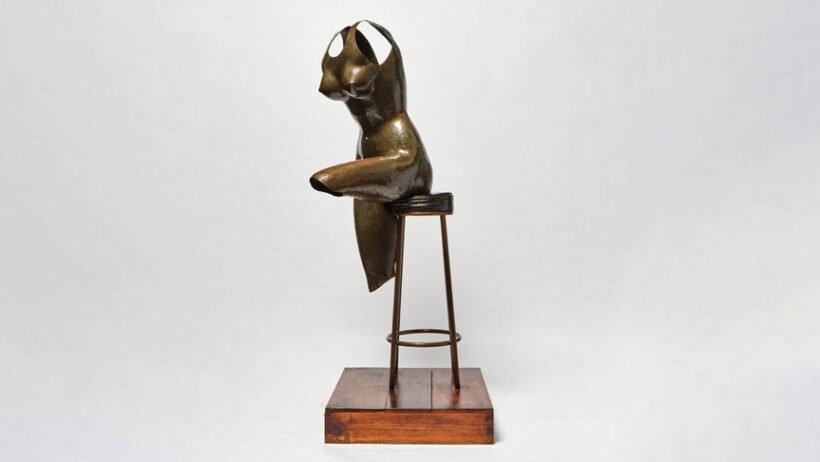I. Introduction: Unveiling James Metcalf
James Metcalf (1925–2012) was far more than just a sculptor; he was a true artistic polymath, an educator, and a cultural bridge-builder whose influence spanned continents and artistic disciplines. His remarkable journey, from a decorated war veteran to a master metalworker, left an indelible mark on the global art scene.
Metcalf’s distinctive approach to sculpture, deeply rooted in ancient metallurgy and an innate understanding of his chosen materials, set him apart as a visionary innovator. He passionately advocated for the harmonious blend of traditional craftsmanship with bold, modern artistic expression.
II. Early Life and Artistic Formation
Born into a family of artists in New York City, James Metcalf’s destiny seemed preordained. Both his parents were accomplished stained glass artists, and this early immersion in intricate craft undoubtedly laid the foundation for his lifelong fascination with material and form.
His formative years were dramatically shaped by service in World War II, where he bravely fought in northern Italy and suffered significant injuries. This profound experience instilled in him a resilience and perspective that would later inform his art. Following his military discharge, Metcalf pursued a rigorous formal art education, first at the prestigious Pennsylvania Academy of the Fine Arts in Philadelphia, and later at the esteemed Central School of Arts and Crafts in London.
III. European Odyssey: Collaborations and Artistic Evolution
The 1950s marked a pivotal period of exploration and growth for Metcalf in Europe. He delved into the study of ancient metallurgy, eventually settling in the picturesque village of Deià, Majorca. It was here that he forged a significant collaboration with the celebrated writer Robert Graves, contributing intricate wood-engravings for Graves’ seminal work, Adam’s Rib.
His artistic journey continued to flourish in Paris from 1956 to 1965. His studio at Impasse Ronsin became a vibrant nexus for artistic exchange, drawing in influential figures such as Marcel Duchamp, Man Ray, and Jean Tinguely. These rich interactions further honed his unique sculptural language, pushing the boundaries of his creative expression.
IV. The Mexican Chapter: A Return to Craft and Community
By 1965, despite his burgeoning success in the contemporary art world, Metcalf felt a profound pull towards a different path, leading him to Mexico. This move proved to be a transformative turning point, as he became deeply embedded within the vibrant local artisan communities.
In Santa Clara del Cobre, Michoacán, Metcalf dedicated himself wholeheartedly to the preservation and promotion of indigenous pre-Columbian coppersmithing and forging techniques. Working alongside his talented wife, Ana Pellicer, he co-founded the Adolfo Best Maugard School of Arts and Crafts. This initiative not only revitalized a fading craft but also empowered countless local artisans, breathing new life into their cultural heritage.
V. Artistic Philosophy and Signature Style
Metcalf’s artistic philosophy was characterized by an unwavering reverence for material and process. He firmly believed that the artwork resided inherently within the material itself, waiting to be revealed. While he often favored manual techniques over power tools, he was also pragmatic, integrating machinery when it served to achieve specific, complex forms.
His sculptures are instantly recognizable for their biomorphic qualities, seamlessly blending organic shapes with a sophisticated understanding of metal. He drew inspiration from a vast array of sources, including Gothic, Romanesque, and Medieval art, as well as the intricate surface ornamentation of Celtic art. His mature works were notably influenced by topology, a branch of mathematics that explores the transformation of volume, allowing him to create dynamic interplay between inner and outer forms.
VI. Impact and Legacy
James Metcalf’s influence extended far beyond his individual artistic creations. His tireless efforts in Santa Clara del Cobre transformed the town into a globally recognized hub for copper craftsmanship. A testament to his impact was the commission to forge the iconic Olympic torch for the 1968 Summer Olympics in Mexico City, an event that cemented the town’s international reputation.
He is celebrated not merely as a master sculptor but as a visionary cultural innovator who skillfully bridged the divide between ancient traditions and avant-garde artistic thought. His profound legacy endures through the generations of artisans he inspired and the compelling body of work that continues to captivate and challenge audiences worldwide.
VII. Conclusion: A Master of Metal and Culture
James Metcalf’s life story is a powerful narrative of artistic devotion, deep cultural engagement, and an unyielding pursuit of innovation. From the harrowing battlefields of World War II to the dynamic art scenes of Europe and the rich artisanal heartland of Mexico, he carved out a path that was uniquely his own.
His extraordinary ability to synthesize ancient techniques with modern sensibilities, coupled with his unwavering commitment to community and education, firmly establishes him as a pivotal figure in 20th-century art. Metcalf’s work continues to resonate, offering a profound and enduring dialogue between material, form, and the boundless spirit of human endeavor.








